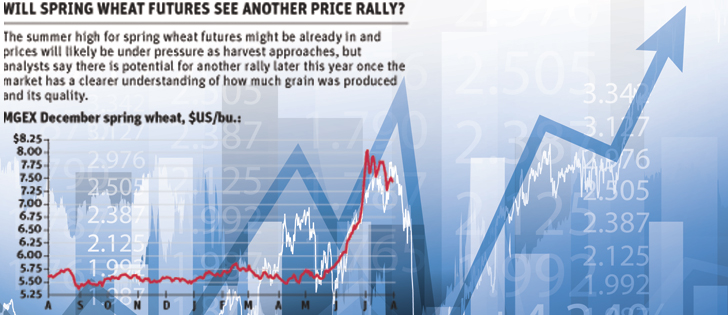The recent slump in hard red spring wheat futures doesn’t necessarily mean the 2017-18 rally is done and dusted, say some analysts.
However, it might be weeks or months before a more permanent pricing level is established, following what might be the climax of the summer spike.
“We have to wait,” said analyst Darin Newsom of DTN.
Jon Driedger of FarmLink Marketing said spring wheat’s ultimate peak might or might not have been reached in early July, when various Minneapolis futures contract months and cash prices ranged from US$8 to more than $9, so farmers shouldn’t assume the present decline is permanent.
Read Also

Biofuel sector happy with federal budget
Advanced Biofuels Canada says new Biofuel Production Incentive is a lifeline until CFR amendments are in place.
“It’s hard to say, but the outlook is pretty good,” said Driedger.
Neither were surprised to see Minneapolis spring wheat futures fall after soaring high in early summer. The form of the rise, the dynamics behind its strength and the stage of the crop all made the peak and decline relatively orthodox.
“What we saw was a picture-perfect short-supply spike rally,” said Newsom.
“Once we accept the fact that the supplies are tight and we get closer to harvest, there’s almost always this immediate tipping point where commercials (companies that use physical grain) go from buyers to sellers, or they step out of the market because they have bought or locked in everything that they need.”
Newsom said the higher nearby futures prices in the early summer proved to him that commercial users were leading the rally, and their hunger for protein was clear in the growing spread between spring wheat and winter wheat contracts.
The 2012 U.S. Midwest corn and soybean rally was similar with commercial users buying futures to protect their obligations, scrambling as the 2012 drought grew in severity. However, they stopped buying once they had needs covered, and speculators soon saw prices swoon as the “vacuum” of aggressive buyers beneath surging prices allowed prices to fall hard weeks before the corn and soybean crops were done growing.
Today, the spring wheat futures market has been falling for weeks, even as drought has worsened in much of the U.S. and Canadian growing areas. The U.S Hard Red Spring Wheat and Durum Tour (conducted in the last week of July) estimated a U.S. spring wheat crop of only 38.1 bushels per acre, compared to the tour’s estimate of 45.7 in 2016. Durum was estimated to be 39.7 bu. per acre, compared to 45.4 last year.
Spring wheat futures have fallen weeks before the Canadian crop is mature with more damage possible. However, most of that damage has already been baked into futures prices and the situation is now one of commercial users ignoring the market and farmers beginning to have harvested crop to sell.
As new crop supplies begin to flow in to elevators, selling pressure builds on the futures market and prices are likely to have trouble rallying significantly, although day to day gyrations are inevitable, Newsom and Driedger said.
“The minute the combines start to roll, or even when people start talking about harvest, the pressure comes in,” said Newsom.
Driedger said cash prices are less volatile, and he’s more confident following those in coming weeks. Futures markets are volatile and tend to overreact to every new influence in the market, while cash markets are more staid.
“It’s just the wild west in that (futures) market. If I was just straight trading, I’d be terrified to be short or long,” said Driedger.
However, Driedger and Newsom said futures and cash prices should begin to align more tightly and in a more stable relationship once harvest pressure is done and once commercial users need another round of supply.
“We have to wait for the commercial side to come in again,” said Newsom.
“It’s only once we move through that initial supply that we start to re-evaluate or re-adjust where these markets need to be.”
That’s why Driedger said farmers might see another rally leg in the late fall or winter. However, much depends on other wheat markets and other crop prices because spring wheat can only go so far by itself.
“There’s no shortage of wheat globally. There’s just a shortage of this type of wheat,” said Driedger.
The summer 2017 rally has shown farmers the role of the futures market clearly. As the crop began to have problems, users that needed supplies raced to cover their obligations, which drove up prices.
Higher prices drove off demand, and the market settled back into a less panicked state even as the drought worsens.
“The job of the market, if crops are tight, is to ration demand,” said Driedger.
“Markets do that early.”
















